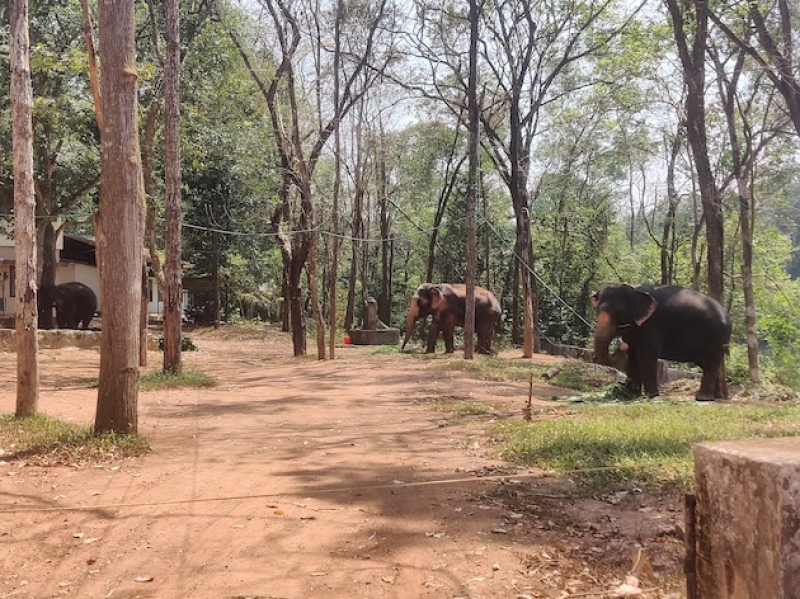- As debate over the location of climate conference razes on, will COP fail this time too? |
- UN Rights Office Warns of Gaza Escalation, West Bank Annexation |
- UN Warns Wildfires and Climate Change Worsen Air Quality |
- OIC Hails Belgian Declaration of Intent to Recognize Palestinian State |
- Bomb blast kills 15 near political rally in Pakistan |
Kerala’s Human–Elephant Conflict: Beyond Simple Blame

Elephants at the Kappukadu elephant rehabilitation center in Kottoor.
In the early part of this year, two deaths in Kerala drew major attention. A farmer in Wayanad and a female plantation worker in Idukki were killed in separate incidents within a few days, both by wild elephants.
Arikomban, another wild elephant, has also become a media favourite due to frequent encounters near human settlements. Named for his love of ari (rice), the elephant was relocated from Kerala to Tamil Nadu in 2023 after protests from residents who described him as a threat to life. His relocation was widely covered in Kerala’s media.
These are not isolated cases. Kerala has seen a sharp rise in human–wildlife conflict, particularly involving elephants. According to reports, 451 people have died in wildlife encounters over the past five years, 102 of them in elephant-related incidents.
However, wildlife biologists and environmentalists challenge how these events are labelled.
“I think we shouldn’t use the term ‘wildlife conflict.’ I prefer ‘negative wildlife interaction,’” says Dr P.S. Easa, an elephant ecology expert and member of the National Board for Wildlife and the IUCN Asian Elephant Specialist Group.
He explains that human–animal tensions have existed for centuries but are now shaped by changes in behaviour and human perceptions of wildlife. In Kerala, the issue of human–elephant conflict carries deeper cultural significance. Elephants have long been part of the state’s culture—used for labour in the past and still featured in temple festivals. Despite stricter rules, their use in festivals continues, making the subject sensitive and politically delicate.
Easa rejects the term “domesticated elephants,” arguing that “captive elephants” is the more accurate description. In 2024 alone, nine people were killed by captive elephants, six of them in the first two months.
Kerala has four major elephant reserves—Wayanad, Nilambur, Anamudi, and Periyar—with a combined area of 11,199 sq km. A 2024 assessment put the state’s elephant population at just under 1,800, down by more than 100 from the previous year.
Experts attribute frequent human–elephant encounters to shrinking forests, deforestation, and expanding human settlements in elephant habitats. Climate change and invasive plants further reduce food sources, driving elephants into new areas. Easa notes:
“The phrase ‘descent of wildlife into human settlements’ is misleading. In most cases, it is humans who have occupied areas once home to wildlife.”
Tourism has worsened the problem, with food waste attracting elephants, wild boars, and monkeys into towns and villages.
There is no single solution, scientists caution. Methods that worked in Africa failed in countries like Sri Lanka and Indonesia. Wildlife biologist Sreedhar Vijayakrishnan recommends long-term research on elephant movement, early-warning systems, awareness campaigns, rapid-response teams, and fitting satellite collars to problematic elephants.
Kerala has also developed an elephant rehabilitation centre in Kottoor, Thiruvananthapuram, and continues to train Kumki elephants for conflict management. Another notable effort is the Wayanad Elephant Conflict Mitigation Project, launched in 2002 by the Wildlife Trust of India (WTI). The project relocates human settlements from elephant corridors, handing over the land to the state’s Forest Department.
“In some areas, such as the Tirunelli–Kudrakote corridor, human deaths were frequent,” says Shajan M.A., Senior Field Officer with WTI. “Relocation has been the most effective long-term solution, though never easy for families leaving their homes.”
Shajan reflects on the broader question:
“Conflict can mean different things—from a monkey stealing food to a tiger or elephant attack. Sadly, society reacts only when it escalates, often blaming wildlife entirely.”

